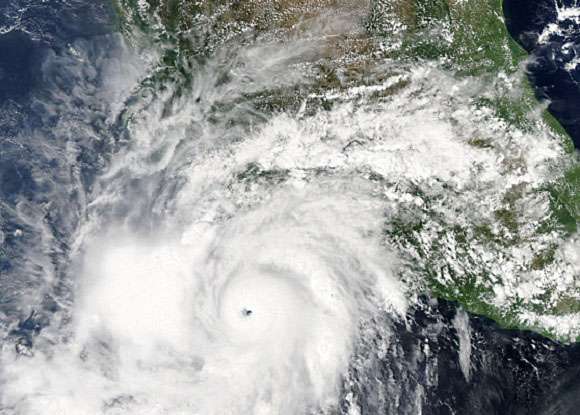Scientists develop better approach to predict the intensity of tropical hurricanes

Category 1, Category 3, the dreaded Category 5—Americans are becoming too familiar with the ratings of hurricanes or tropical cyclones. Scientists use a measure called Potential Intensity to help them forecast the strength of tropical cyclones, aka hurricanes or typhoons. Unfortunately, that measure does not accurately take into account how the ocean subsurface conditions help fuel such storms. A team of scientists led by researchers at Pacific Northwest National Laboratory modified the current formula to calculate Potential Intensity by including the effects of upper-ocean mixing, sea-surface cooling, and salinity during a cyclone. The improved formula nearly doubles the accuracy in forecasting tropical cyclone intensification.
"This study is the first to show the value of using ocean salinity measurements to forecast the intensity of tropical cyclones," said team lead Dr. Karthik Balaguru, an oceanographer at PNNL's Marine Sciences Laboratory. "With the hydrological cycle projected to change under global warming, impacting upper-ocean stratification and mixing, the results from this study have potentially important implications for understanding future tropical cyclone activity."
Tropical cyclones rank among the most destructive and deadliest natural hazards, affecting millions of people annually across the world. With widespread social and economic impacts associated with a cyclone's power, improving the accuracy of tropical cyclone forecasts is of paramount importance for mitigating damage. Potential Intensity, a theoretical framework of large-scale ocean-atmosphere processes, helps scientists forecast the power of a cyclone. Within that framework, the level of heat in the upper part of the ocean is represented by the temperature of the sea surface before the storm arrives. However, as a tropical cyclone approaches, it churns up colder, deeper water that cools the ocean surface, lowering the temperature several degrees ahead of the storm. The new formula developed by the PNNL-led team takes this change as well as changes in salinity into account to more accurately represent the ocean-storm interaction.
As reported in Geophysical Research Letters, the team led by scientists from PNNL and the National Oceanic and Atmospheric Administration's Atlantic Oceanographic and Meteorological Laboratory used both observations and models to derive their new formula. For observations, they gathered data from three sources:
- 10 years of cyclone track data from the National Hurricane Center and the U.S. Navy's Joint Typhoon Warning Center
- Air temperature, humidity, and sea-level pressure data from a continuously updated atmospheric analysis called ERA-Interim
- Subsurface ocean temperature and salinity data from a world-wide network of free-driftingfloats, known as Argo,that constantly measure the temperature and salinity of the upper 2,000 meters of the ocean.
The team fed this wealth of information into a model that estimates the mixing of ocean layers. They then compared the results from their new formula to actual cyclone intensification data at each location along tropical cyclone tracks in the Atlantic, Eastern Pacific, and Northwest Pacific for the 10-year period 2004 through 2013. The new formula was twice as likely as the previous formula to accurately forecast the rate at which cyclones would intensify.
Hydrological cycle changes expected under global warming may alter the salinity of the upper ocean. While the new formula, which accounts for both temperature and salinity, can be used to forecast tropical cyclone intensity in real time, it can also be applied to the results of climate modeling to provide scientists with a framework to evaluate changes in future tropical cyclone activity.
More information: "Dynamic Potential Intensity: An Improved Representation of the Ocean's Impact on Tropical Cyclones." Geophysical Research Letters 42(16):6739-6746. DOI: 10.1002/2015GL064822
Journal information: Geophysical Research Letters
Provided by Pacific Northwest National Laboratory





















